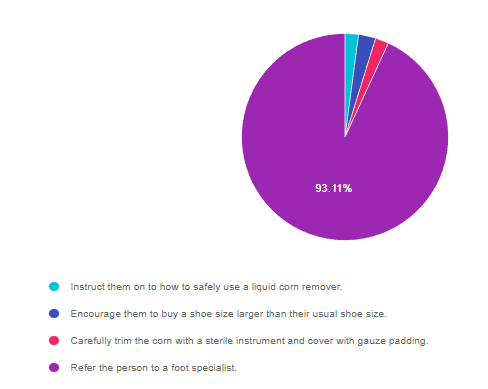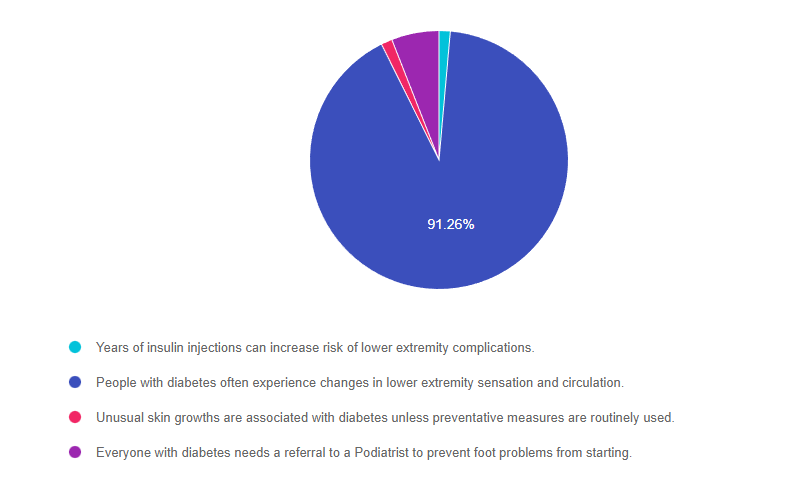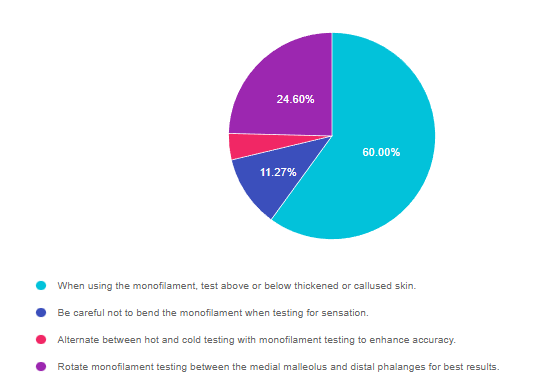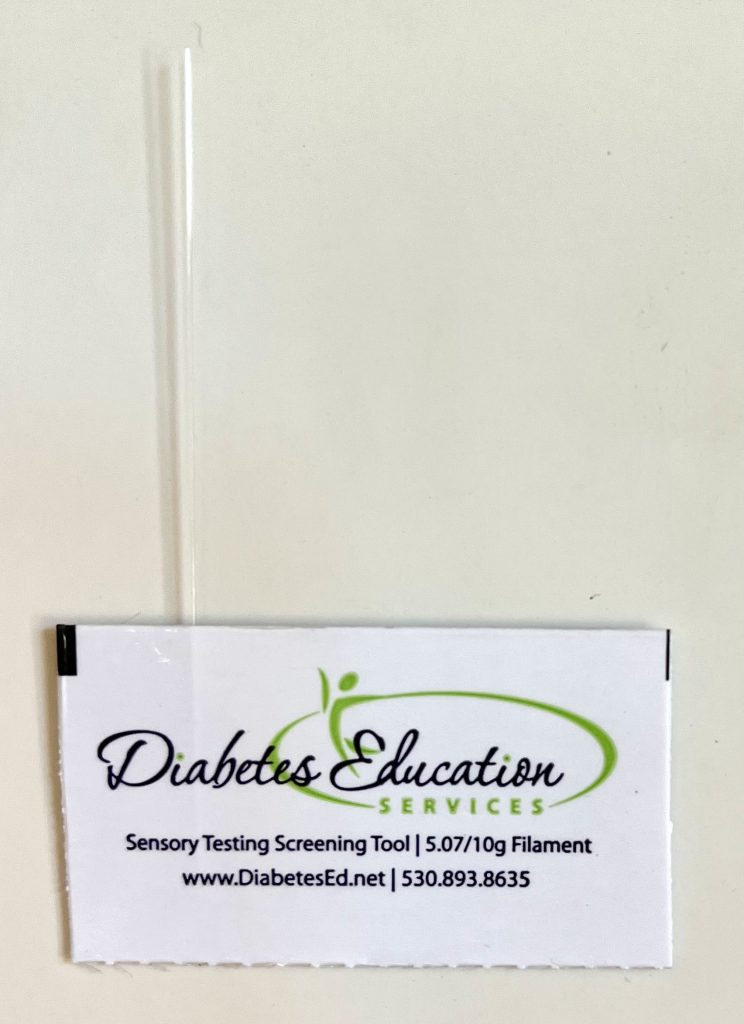Question of the Week | Premeal Glucose is Too Low

RL carb counts and takes 1 unit of insulin for every 10 gms of carbohydrate. RL also uses a correction ratio and takes 1 unit for every 40 points above their glucose target of 120. RL’s asks you what to do if their premeal glucose is less than 70 before their lunch meal at work. RL often has blood sugar drops right before lunch and usually eats a sandwich, chips, berries and some sparkling water for lunch.
Given the situation, what is the best recommendation for JL to do if their pre-lunch glucose is less than 70 mg/g?
- Immediately eat 15gms of berries and recheck glucose in 15 minutes.
- Decrease usual insulin carb coverage for this meal by 1 or 2 units.
- Encourage JL to eat lunch immediately and give insulin afterward.
- Discuss which strategies would work best for RL in this situation.
Click Here to Test your Knowledge
Want to learn more about this question?
Enroll in our upcoming webinar
Solving Glucose Mysteries for Type 1
Airs live on August 9th at 11:30 am PST

Why do the blood sugars keep dropping after meals? Is the basal insulin set correctly? What adjustments are needed for exercise?
During this webinar, Coach Beverly addresses each of these glucose mysteries and more, using a person-centered approach. She describes a stepwise approach to evaluate glucose patterns and correct common issues encountered by people living with type 1 diabetes.
Objectives:
- Describe common glucose mysteries encountered by people with type 1 diabetes.
- Using a stepwise approach, evaluate factors affecting glucose patterns.
- State interventions to increase time-in-range and improve quality of life.
Can’t join us live?
Don’t worry, we will send you a link to the recorded version.

Coach Beverly Thomassian, RN, MPH, BC-ADM, CDCES
Author, Nurse, Educator, Clinician and Innovator, Beverly has specialized in diabetes management for over twenty years. As president and founder of Diabetes Educational Services, Beverly is dedicated to optimizing diabetes care and improving the lives of those with diabetes.
Sign up for Diabetes Blog Bytes – we post one daily Blog Byte from Monday to Friday. And of course, Tuesday is our Question of the Week. It’s Informative and FREE! Sign up below!
The use of DES products does not guarantee the successful passage of the CDCES exam. CBDCE does not endorse any preparatory or review materials for the CDCES exam, except for those published by CBDCE.
Uvalde T-Shirt Clothesline on display at Museum of Northern California Art (monca)
Installation Connects Common Humanity Through Art

CHICO, CA, Sept 19, 2022—**Dismayed over the horrific school shooting that occurred in Uvalde, Texas on May 24, a group of local mothers organized an art installation featuring 21 orange t-shirts, hand-painted with the names of the children and teachers who died. The Uvalde T-Shirt Clothesline was displayed at the Chico Farmer’s Market on July 2nd and now graces the front arches of the Museum of Northern California Art (monca). Orange is the commemorative color of gun violence prevention. Since 2020, firearms have become the leading cause of death for children in the United States, surpassing motor vehicle accidents.[1] Every 2 hours and 36 minutes, a child loses their life due to firearm violence, accidents, or suicide.[2]
“The Uvalde T-Shirt Clothesline speaks of the empty shirts left behind: shirts that will never be played in, worn to school, or hugged at night. Shirts whose young owners will never reach their full potential.” – Beverly Thomassian
“Hanging shirts to dry on a line is a common household activity. The fact that our kids are growing up in a culture of gun violence and school shootings, that they do drills in school to practice how to respond in case of an actual violent attack, that this has become so routine, so commonplace–as ordinary as doing laundry–is why this installation of empty shirts hung on a clothesline has such an immediate, powerful effect.” – Amy Antongiovanni
Be SMART – Gun Safety Alliance of Northern California is a newly formed local chapter of the national Be SMART for Kids campaign. Our goals are:
- to shine a light on the problem of gun violence against children
- to connect our common humanity through art
- to raise awareness that secure gun storage—storing guns locked, unloaded and separate from ammunition—can save children’s lives
Contact – Beverly Thomassian, Be SMART Advocate, [email protected]
[1] Current Causes of Death in Children and Adolescents in the United States, N Engl J Med, May 19 2022; 386:1955-1956, DOI: 10.1056/NEJMc2201761
[2] https://www.childrensdefense.org/policy/policy-priorities/gun-violence-prevention/
Press Release
Download Press Release here
T-Shirt Clothesline Tribute makes local paper front page.
Read Enterprise Record Article here.
Resources
Nurses Union Addresses Gun Violence
Art Displays
Uvalde mural honors Robb Elementary School shooting
More information here
Rationale of the Week | Best action to treat a corn?

For last week’s practice question, we quizzed test takers on why diabetes foot care is important. 93% of respondents chose the best answer. We want to share this important information, so you can pass it on to people living with diabetes and your colleagues, plus prepare for exam success!
Before we start though, if you don’t want any spoilers and haven’t tried the question yet, you can answer it below: Answer Question
Question: A person with diabetes has small corn on their pinky toe and it bothers them when walking.
What is the best first action?
Answer Choices:
- Instruct them on to how to safely use a liquid corn remover.
- Encourage them to buy a shoe size larger than their usual shoe size.
- Carefully trim the corn with a sterile instrument and cover with gauze padding.
- Refer the person to a foot specialist.

As shown above, the most common choice was option 4, the second most common answer was option 2, then a tie for options 1 and 3.
Getting to the Best Answer
Answer 1 is incorrect. 2.10% chose this answer, “Instruct them on to how to safely use a liquid corn remover.” The problem with corn and callus liquid or patch treatments, is that they contain salicylic acid, which can remove the callus/corn, but also damage the healthy tissue underneath. This disruption in skin integrity can lead to ulcerations and increase the risk of skin infections, especially if the person with diabetes is experiencing blood glucose elevations. We have created foot care education sheets in English and Spanish that you are invited to print and share. Let’s prevent the agony of “DeFeet”. Foot Care Teaching Sheet – Steps to Healthy Feet. Foot Care Teaching Sheet in Spanish– Pasos Para Tener Pies Sanos.
Answer 2 is incorrect. 2.69% of you chose this answer, “Encourage them to buy a shoe size larger than their usual shoe size.” While it is important to make sure there is plenty of room to wiggle toes and avoid rubbing from tight fitting shoes, it is also important to avoid ill fitting shoes. Wearing too large of shoes can lead to slippage and increased friction resulting in blisters and ulcers. These teaching sheets demonstrate an easy strategy to make sure that people are wearing the best size shoes for their foot shape. Foot Care Teaching Sheet – Steps to Healthy Feet. Foot Care Teaching Sheet in Spanish– Pasos Para Tener Pies Sanos.
Answer 3 is incorrect. 2.10% of respondents chose this answer, “Carefully trim the corn with a sterile instrument and cover with gauze padding.” People diabetes are strongly discouraged from performing any “bathroom surgery” to self-treat foot problems. Approved foot care tools for foot care include, nail clippers, nail file, soap and water, washcloth, gentle scrub brush, lotions, socks and shoes. We have created foot care education sheets in English and Spanish that you are invited to print and share. Let’s prevent the agony of “DeFeet”. Foot Care Teaching Sheet – Steps to Healthy Feet. Foot Care Teaching Sheet in Spanish– Pasos Para Tener Pies Sanos.
Finally, Answer 4 is incorrect. 93.11% chose this answer, “Refer the person to a foot specialist.” GREAT JOB. Most people chose this answer for good reason, the action of referring a person with foot problems to a Podiatrist significantly reduces the risk of ulceration, infection and amputation. By identifying and referring people with high risk feet to specialists, we can reverse the trend of increasing amputations and improve quality of life. We are happy to share these free lower extremity education handouts with you. Please feel free to print and share! Foot Care Teaching Sheet – Steps to Healthy Feet. Foot Care Teaching Sheet in Spanish– Pasos Para Tener Pies Sanos.
Want to learn more about this question?
Enroll in our Foot Screening Bundle, now on Sale!
This bundle includes our 3 Steps to Save Feet; Assess, Screen, and Report Webinar + 20-pack of Monofilament + ADA Foot Screening Chart
People with diabetes are at increased risk of foot complications. Basic foot care education and intervention can reduce the risk of amputation by over 50 percent.
This bundle comes with our:
We have included instructions on assessing and inspecting feet, risk assessment, and action steps. We enhanced the teaching tools and forms from the Lower Extremity Prevention Program (LEAP) and are excited to share them with our community of diabetes advocates.
FREE Resources for Health Care Professionals and People with Diabetes
3 Steps to Save Feet – Assess, Screen, Report Handout. This handout walks health care professionals through the steps involved in a 10-minute foot assessment and monofilament screening. Also includes a Screening Form to document and report findings.
Foot Care Teaching Sheet – Steps to Healthy Feet. This handout covers the important elements of foot care for people living with diabetes with simple and straightforward language.
Foot Care Teaching Sheet in Spanish– Pasos Para Tener Pies Sanos. This handout covers the important elements of foot care for people living with diabetes with simple and straightforward language.
FREE Handouts and Resources
Read More: FREE Handouts and Resources 3 Steps to Save Feet – Assess, Screen, Report Handout. This handout walks health care professionals through the steps involved in a 10-minute foot assessment and monofilament screening. Also includes a Screening Form to document and report findings. Foot Care Teaching Sheet – Steps to Healthy Feet. This handout covers the important elements of foot care for people living with diabetes with simple and straightforward language. Foot Care Teaching Sheet in Spanish– Pasos Para Tener Pies Sanos. This handout covers the important elements of foot care for people living with diabetes with simple and straightforward language. Sign up for Diabetes Blog Bytes – we post one daily Blog Byte from Monday to Friday. And of course, Tuesday is our Question of the Week. It’s Informative and FREE! Sign up below! The use of DES products does not guarantee the successful passage of the CDCES exam. CBDCE does not endorse any preparatory or review materials for the CDCES exam, except for those published by CBDCE. JR is 38 years old and takes insulin twice a day. They mention they were going to the bathroom at night, lost their balance and scraped their shin. They put a band-aid on it, but want you to take a look. What is the best approach to treat the abrasion? Click Here to Test your Knowledge 3 Steps to Save Feet – Assess, Screen, Report Handout. This handout walks health care professionals through the steps involved in a 10-minute foot assessment and monofilament screening. Also includes a Screening Form to document and report findings. Foot Care Teaching Sheet – Steps to Healthy Feet. This handout covers the important elements of foot care for people living with diabetes with simple and straightforward language. Foot Care Teaching Sheet in Spanish– Pasos Para Tener Pies Sanos. This handout covers the important elements of foot care for people living with diabetes with simple and straightforward language. Coach Beverly Thomassian, RN, MPH, BC-ADM, CDCES Author, Nurse, Educator, Clinician and Innovator, Beverly has specialized in diabetes management for over twenty years. As president and founder of Diabetes Educational Services, Beverly is dedicated to optimizing diabetes care and improving the lives of those with diabetes. Sign up for Diabetes Blog Bytes – we post one daily Blog Byte from Monday to Friday. And of course, Tuesday is our Question of the Week. It’s Informative and FREE! Sign up below! The use of DES products does not guarantee the successful passage of the CDCES exam. CBDCE does not endorse any preparatory or review materials for the CDCES exam, except for those published by CBDCE. For last week’s practice question, we quizzed test takers on why diabetes foot care is important. 91% of respondents chose the best answer. We want to share this important information, so you can pass it on to people living with diabetes and your colleagues, plus prepare for exam success! Before we start though, if you don’t want any spoilers and haven’t tried the question yet, you can answer it below: Answer Question Question: Why is it important that people with diabetes pay special attention to taking care of their feet? Answer Choices: As shown above, the most common choice was option 2, the second most common answer was option 4, then a tie for options 1 and 3. Answer 1 is incorrect. 1.39% chose this answer, “Years of insulin injections can increase risk of lower extremity complications.” Insulin injections don’t increase the risk of lower extremity problems and they might even reduce the risk of vascular disease by improving blood glucose levels. Answer 2 is correct. 91.29% of you chose this answer, “People with diabetes often experience changes in lower extremity sensation and circulation.” YES, GREAT JOB. Diabetes can contribute to increased risk of vessel disease and neuropathy if blood glucose levels and blood pressure readings are chronically above target. Of course, genetics and environment also play a role in increasing or decreasing the risk of lower extremity complications. By providing people with diabetes strategies to protect lower extremities and care for their feet, health care professionals make a big dent in improving outcomes. We have free patient education handouts that you are welcome to share with the clients you serve. Foot Care Teaching Sheet – Steps to Healthy Feet. This handout covers the important elements of foot care for people living with diabetes with simple and straightforward language and is also available in Spanish, Foot Care Teaching Sheet in Spanish– Pasos Para Tener Pies Sanos. Answer 3 is incorrect. 1.39% of respondents chose this answer, “Unusual skin growths are associated with diabetes unless preventative measures are routinely used.” People with diabetes are not at increased risk of skin growths, however they are at risk for fungal infections, especially if blood sugars are elevated. Keeping feet clean and dry, especially in between toes can help ward off infections and interdigit maceration. We have free patient education handouts that you are welcome to share with the clients you serve. Foot Care Teaching Sheet – Steps to Healthy Feet. This handout covers the important elements of foot care for people living with diabetes with simple and straightforward language and is also available in Spanish, Foot Care Teaching Sheet in Spanish– Pasos Para Tener Pies Sanos. Finally, Answer 4 is incorrect. 5.92% chose this answer, “Everyone with diabetes needs a referral to a Podiatrist to prevent foot problems from starting.” A person with diabetes, well managed glucose levels, who can safely provide their own foot care does not need a referral to a Podiatrist. However, people with neuropathy, vascular disease, foot deformities, thick toenails, or a history of foot problems, usually benefit from being referred to a Podiatrist for assessment and care. You can download or free 3 Steps to Save Feet – Assess, Screen, Report Handout. This handout walks health care professionals through the steps involved in a 10-minute foot assessment and monofilament screening. Also includes a Screening Form to document and report findings. People with diabetes are at increased risk of foot complications. Basic foot care education and intervention can reduce the risk of amputation by over 50 percent. This bundle comes with our: We have included instructions on assessing and inspecting feet, risk assessment, and action steps. We enhanced the teaching tools and forms from the Lower Extremity Prevention Program (LEAP) and are excited to share them with our community of diabetes advocates. Read More: FREE Handouts and Resources 3 Steps to Save Feet – Assess, Screen, Report Handout. This handout walks health care professionals through the steps involved in a 10-minute foot assessment and monofilament screening. Also includes a Screening Form to document and report findings. Foot Care Teaching Sheet – Steps to Healthy Feet. This handout covers the important elements of foot care for people living with diabetes with simple and straightforward language. Foot Care Teaching Sheet in Spanish– Pasos Para Tener Pies Sanos. This handout covers the important elements of foot care for people living with diabetes with simple and straightforward language. Sign up for Diabetes Blog Bytes – we post one daily Blog Byte from Monday to Friday. And of course, Tuesday is our Question of the Week. It’s Informative and FREE! Sign up below! The use of DES products does not guarantee the successful passage of the CDCES exam. CBDCE does not endorse any preparatory or review materials for the CDCES exam, except for those published by CBDCE. A person with diabetes has small corn on their pinky toe and it bothers them when walking. What is the best first action? Click Here to Test your Knowledge 3 Steps to Save Feet – Assess, Screen, Report Handout. This handout walks health care professionals through the steps involved in a 10-minute foot assessment and monofilament screening. Also includes a Screening Form to document and report findings. Foot Care Teaching Sheet – Steps to Healthy Feet. This handout covers the important elements of foot care for people living with diabetes with simple and straightforward language. Foot Care Teaching Sheet in Spanish– Pasos Para Tener Pies Sanos. This handout covers the important elements of foot care for people living with diabetes with simple and straightforward language. Coach Beverly Thomassian, RN, MPH, BC-ADM, CDCES Author, Nurse, Educator, Clinician and Innovator, Beverly has specialized in diabetes management for over twenty years. As president and founder of Diabetes Educational Services, Beverly is dedicated to optimizing diabetes care and improving the lives of those with diabetes. Sign up for Diabetes Blog Bytes – we post one daily Blog Byte from Monday to Friday. And of course, Tuesday is our Question of the Week. It’s Informative and FREE! Sign up below! The use of DES products does not guarantee the successful passage of the CDCES exam. CBDCE does not endorse any preparatory or review materials for the CDCES exam, except for those published by CBDCE. We have created a Foot Care Toolkit! This toolkit includes a Handout on how to perform a 10-minute foot assessment, a patient education handout, plus a webinar detailing how to use these tools. Plus, we now offer discounted monofilaments that you can use in your practice setting. 3 Steps to Save Feet – Assess, Screen, Report Handout. This handout walks health care professionals through the steps involved in a 10-minute foot assessment and monofilament screening. Also includes a Screening Form to document and report findings. Foot Care Teaching Sheet – Steps to Healthy Feet. This handout covers the important elements of foot care for people living with diabetes with simple and straightforward language. Foot Care Teaching Sheet in Spanish– Pasos Para Tener Pies Sanos. This handout covers the important elements of foot care for people living with diabetes with simple and straightforward language. Webinar: Coach Beverly will walk participants through the 3 Step Process to Save Feet; Assess, Screen and Report. She will provide simple and clear instructions on how to assess and inspect feet, along with risk assessment and action steps. We will share free teaching tools, strategies, and documentation forms adapted from the Lower Extremity Prevention Program (LEAP) that you can immediately implement in your practice setting. No matter your profession, learning the basics of lower extremity assessment can help you to identify when people with diabetes are in jeopardy of serious foot problems. Basic foot care assessment and education can reduce the risk of amputation by over 50%. According to a 2019 article published in Diabetes Care, the rate of amputations in the U.S. is increasing. Each year, people with diabetes experience over 100,000 non-traumatic amputations. In the United States, every 17 seconds someone is diagnosed with diabetes, and every day 230 Americans with diabetes will suffer an amputation. There are also major health disparities in people at the highest risk of losing their lower extremities. African Americans are 4 times more likely to experience diabetes-related amputation than whites. If each one of us reading this article prevented ONE amputation, we could prevent 40, 000 amputations. By assessing and screening for feet at risk, including using a monofilament to detect loss of protective sensation, diabetes healthcare professionals can immediately identify high-risk feet and take steps to protect lower extremities. Learn how to take an active role in decreasing this devastating loss of limb and often life. For last week’s practice question, we quizzed test takers on the best use of monofilament to check feet. 60% of respondents chose the best answer. We want to share this important information, so you can pass it on to people living with diabetes and your colleagues, plus prepare for exam success! Before we start though, if you don’t want any spoilers and haven’t tried the question yet, you can answer it below: Answer Question Question: ADA Standards of Care recommend using a 5.07 monofilament to evaluate for loss of protective sensation in lower extremities in people with diabetes. Which of the following statements is most accurate regarding using a monofilament to assess lower extremities? Answer Choices: As shown above, the most common choice was option 1, the second most common answer was option 4, then option 2, and finally 3. Answer 1 is correct. 60.00% chose this answer, “When using the monofilament, test above or below thickened or callused skin.” YES, GREAT JOB. Many people with diabetes have calluses and thickened skin that will block the sensation of 10gms of linear pressure delivered by the monofilament. For this reason, avoid areas with thickened insensate skin and test for sensation above or below the callused location. Answer 2 is incorrect. 11.27% of you chose this answer, “Be careful not to bend the monofilament when testing for sensation.” Actually, to deliver 10gms of linear pressure using a monofilament, the examiner needs to slightly bend the 5.07 filament into a “C” position. This will deliver the correct amount of pressure to evaluate if the person is experiencing loss of sensation. Answer 3 is incorrect. 4.13% of respondents chose this answer, “Alternate between hot and cold testing with monofilament testing to enhance accuracy.” Hot and cold testing is a strategy to determine if the person has decreased temperature sensation. However alternating between these two assessment techniques won’t enhance the testing accuracy of the monofilament. Finally, Answer 4 is incorrect. 24.60% chose this answer, “Rotate monofilament testing between the medial malleolus and distal phalanges for best results.” This is a juicy answer with some cool foot terms. The medial malleolus is actually the bump that protrudes on the inner ankle and the distal phalanges are the tips of the toes. The inner ankle is not one of the points of assessment using a monofilament. The large toe, the foot pad and heel are locations included in a foot assessment using a 5.07 monofilament. All health care professionals are invited to join us to learn strategies to protect lower extremities during this FREE Webinar. Coach Beverly will walk participants through the 3 Step Process to Save Feet; Assess, Screen and Report. She will provide simple and clear instructions on how to assess and inspect feet, along with risk assessment and action steps. We will share free teaching tools, strategies, and documentation forms adapted from the Lower Extremity Prevention Program (LEAP) that you can immediately implement in your practice setting. CEs: 1.0 CEs for $19 or No CEs for FREE Topics include: Read More: FREE Handouts and Resources 3 Steps to Save Feet – Assess, Screen, Report Handout. This handout walks health care professionals through the steps involved in a 10-minute foot assessment and monofilament screening. Also includes a Screening Form to document and report findings. Foot Care Teaching Sheet – Steps to Healthy Feet. This handout covers the important elements of foot care for people living with diabetes with simple and straightforward language. Foot Care Teaching Sheet in Spanish– Pasos Para Tener Pies Sanos. This handout covers the important elements of foot care for people living with diabetes with simple and straightforward language. Coach Beverly Thomassian, RN, MPH, BC-ADM, CDCES Author, Nurse, Educator, Clinician and Innovator, Beverly has specialized in diabetes management for over twenty years. As president and founder of Diabetes Educational Services, Beverly is dedicated to optimizing diabetes care and improving the lives of those with diabetes. People with diabetes are at increased risk of foot complications. By using a 5.07 monofilament (delivers 10gms of linear pressure) to assess for loss of sensation, diabetes health care professionals can immediately identify high-risk feet and take steps to protect lower extremities. Basic foot care education and intervention can reduce the risk of amputation by over 50 percent. We are excited to provide these single-use 5.07 monofilaments in packs of 20. We have included instructions on how to assess and inspect feet, along with risk assessment and action steps. We enhanced the teaching tools and forms from the Lower Extremity Prevention Program (LEAP) and are excited to share them with our community of diabetes advocates. Whether you are new to diabetes or a seasoned expert, you’ll benefit from this virtual conference with the latest research plus critical content that you can immediately apply to your clinical practice. Download Course Flyer | Download Schedule If you are seeking a state-of-the-art review of current diabetes care, this course is for you. Our team has been fine-tuning this course for over fifteen years, and we know what you need. This program can also be a great addition to your CDCES or BC-ADM exam study plan. Team of expert faculty includes: Don’t worry if you can’t make it live. Your registration guarantees access to the recorded version in the Online University. All hours earned count toward your CDCES Accreditation Information Sign up for Diabetes Blog Bytes – we post one daily Blog Byte from Monday to Friday. And of course, Tuesday is our Question of the Week. It’s Informative and FREE! Sign up below! The use of DES products does not guarantee the successful passage of the CDCES exam. CBDCE does not endorse any preparatory or review materials for the CDCES exam, except for those published by CBDCE.
Question of the Week | Best treatment for abrasion?

Want to learn more about this question?
Foot Screening Bundle – Purchase Now and save $15!
3 Steps to Save Feet Webinar + Monofilament 20-Pack + ADA Foot ChartCan’t join us live?
Don’t worry, we will send you a link to the recorded version.FREE Handouts and Resources

Rationale of the Week | Why is Diabetes Foot Care So Important?


Getting to the Best Answer
Want to learn more about this question?
Enroll in our Foot Screening Bundle, now on Sale!This bundle includes our 3 Steps to Save Feet; Assess, Screen, and Report Webinar + 20-pack of Monofilament + ADA Foot Screening Chart
FREE Handouts and Resources
Question of the Week | Best action to treat a corn?

Want to learn more about this question?
Foot Screening Bundle – Purchase Now and save $15!3 Steps to Save Feet Webinar Airs live today, July 19th at 11:30 am PST
Can’t join us live?
Don’t worry, we will send you a link to the recorded version.FREE Handouts and Resources

Foot Care Toolkit: A 3-Step Process to Save Feet
All health care professionals are invited to learn how to assess feet.
Foot Care Toolkit
Rationale of the Week | How to use a Monofilament to Check Feet


Getting to the Best Answer
Want to learn more about this question?
Join us for our new FREE Webinar
3 Steps to Save Feet; Assess, Screen, and ReportAirs live July 19th at 11:30 am PST (45 to 60 minutes)
Can’t join us live?
Don’t worry, we will send you a link to the recorded version.FREE Handouts and Resources

NEW! Order Monofilament (5.07) for Diabetes Foot Screening 20-Pack

Want to learn more about Diabetes Care? Join us for our
Virtual DiabetesEd Specialist Conference
30+ CEsAirs October 12-14th, 2022

Join us LIVE for this Virtual Course and enjoy a sense of community!
Two Registration Options








